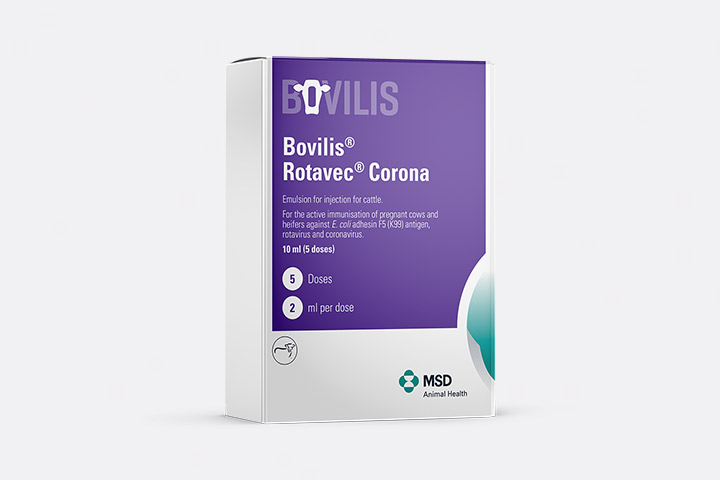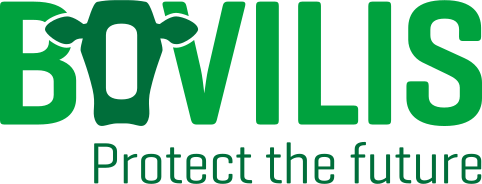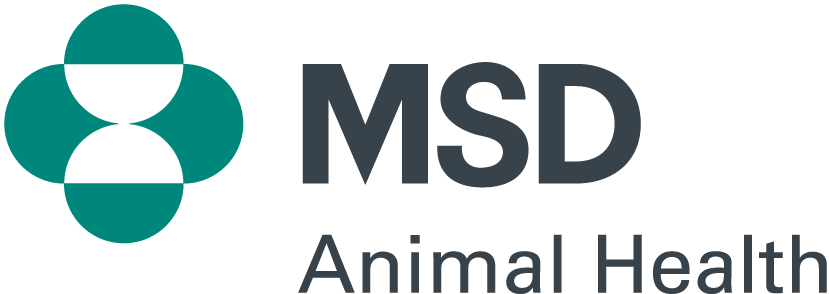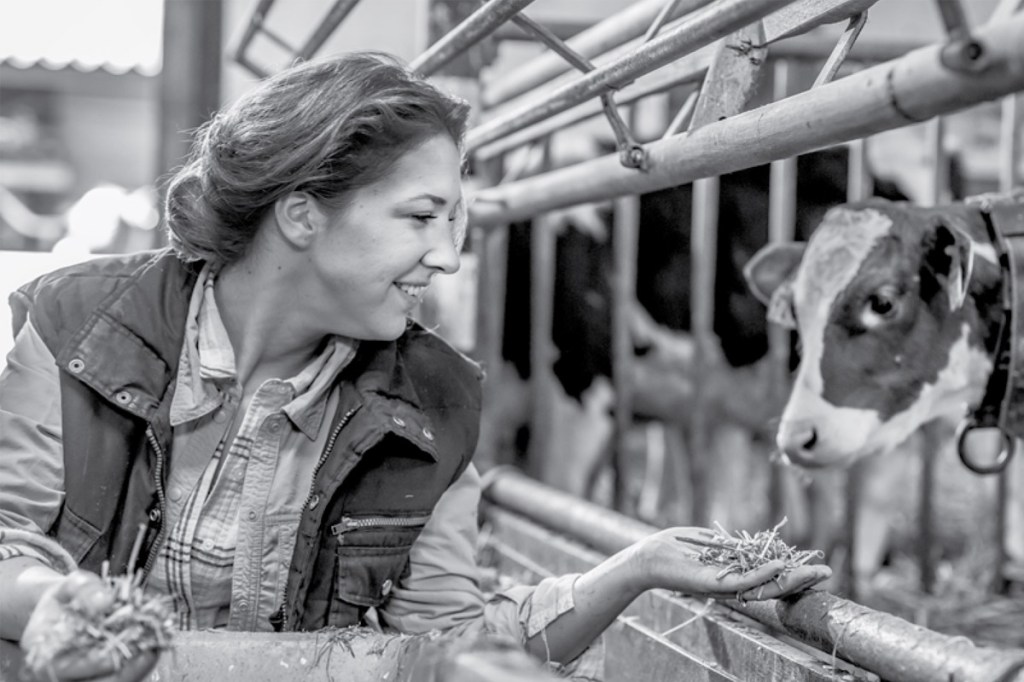

Neonatal Calf Diarrhea
(NCD) or calf scours
Calf sours is still a major threat for your calves in the first month of life and
put them at risk other diseases later on.
● MULTIFACTORIAL DISEASE ● IMPACT OF CALF SCOURS ON GROWTH AND PRODUCTIVITY
● COSTS ASSOCIATED WITH ENTERIC DISEASE ● VACCINATION AGAINST ENTERIC DISEASES
Calf scours is the most common cause of death in calves. It accounts for most deaths in calves less than one month old.1 Pathogens such as rotavirus, coronavirus, Cryptosporidium and E. coli are major causes of infectious calf scours. Most farms have one or all of these pathogens.2 Young calves are very vulnerable in the first weeks of life and multiple factors (e.g., nutrition, hygiene, stress, housing or weather conditions) can trigger calf scours.3 When the dam is vaccinated before calving, she will provide colostrum that gives the calf an extra boost of protection against rotavirus, coronavirus and E. coli.
Multifactorial disease
Infectious enteric disease is nearly always a multifactorial condition. The symptoms of enteric disease include diarrhea, dehydration, depression, weakness, fever or cold extremities, loss of suckle reflex and metabolic acidosis. Therefore in any discussions regarding pathogens involved, the multi-factorial nature of the disease may not be forgotten, and the ability to reduce the exposure of infection with one pathogen, may be critical to maintaining gut health. Currently, enterotoxigenic Escherichia coli (ETEC), Cryptosporidium parvum, rotavirus, and coronavirus appear to be the most significant infectious causes of neonatal calf diarrhoea. In older and adult cattle Clostridium perfringens (various types) can cause enteric disease with acute morbidity and mortality or more extensive herd level problems.
A Spanish study of diarrhoeic dairy calves under 1 month of age found rotavirus in 42% of calves and concurrent presence of other pathogens was found in many calves.4 In rotavirus positive diarrhoea cases they found that calves had 20.4% for corona virus (20%), 85.2% for Cryptosporidium (85%), 16.7% for F5+ E. coli (17%).
A study in young Dutch dairy calves about the prevalence, prediction and risk factors of enteropathogens in normal and non-normal faeces2 indicated that Clostridium perfringens was found in 54% of diarrhoea calves, Cryptosporidium parvum in 43%, whereas E. coli and Corona virus were rarely found. In a study of diarrhoeic dairy calves under 3 weeks of age in Switzerland, the prevalence of Cryptosporidium parvum was 55%, rotavirus was 59%, coronavirus was 8% and ETEC was 6%.
The main causes of scouring and the incidence on UK beef farms sampled through MSD Scour Check during 2009 were: Rota virus (37%), Corona virus (28%), E. coli (5%), Cryptosporidium parvum (30%), and less commonly Coccidia spp and Salmonella spp.
Impact of calf scours on growth and productivity
Enteric disease in calves is very prevalent and has long term consequences in terms of animal growth rate, future lactation productivity and longevity. Calf diarrhoea has been estimated to be the associated with 53-57% of all calf mortality.5 However costs can be five times that figure when calves die as a result of scour.6 The cost of an outbreak of scour in suckler calves was estimated in 2008 to be on average £33 per at risk calf.6 Growth can be reduced substantially and 60% of the costs of diarrhoea are associated with reduced weight gain. In Ireland, pre-weaning growth rates in calves have been reported to decrease, 18% for calves with diarrhoea and 29% for calves with both diarrhoea and respiratory disease.7 Survival to maturity and age at first calving were studied in Canadian Holstein heifers.8 Heifers that had been treated for scours were 2.5 times more likely to be sold and 2.9 times more likely to calve after 900 days of age than other heifers. In an Agri-Food and Bioscience Institute (AFBI) herd in Ireland, calves that had diarrhoea resulted in a 12 kg reduction in live weight at 18 months, and delays in calving.9
A Swedish study of heifers in 107 dairy herds found that heifers that had contracted mild diarrhoea pre-weaning was associated with an estimated 344 Kg reduction in first lactation 305d milk production.10 The authors speculated that this was most likely due to reduced growth and possibly association with respiratory diseases.
Costs associated with enteric disease
Since antibiotics are not effective against virus and antimicrobial agents have limited efficacy against cryptosporidium the treatment of enteric diseases in calves with these products is not successful. The use of antibiotics for common enteric disease may even lead to increased enteric disease due to a disturbance in the gut microbiota that may be associate with reduced growth performance.11 Berge calculated that extensive use of antimicrobials for preweaned calf diarrhoea was furthermore associated with an increased treatment cost of $10 dollars per calf. The best way to reduce the impact of these enteric diseases is through a preventive programme involving good nutrition, management and boosting immunity through vaccinations.
Vaccination against enteric diseases
Rota-Corona-E. coli
Vaccinations of pregnant dams prior to calving to prevent coronavirus, rotavirus and E. coli infections in calves have been shown to be an effective way of decreasing neonatal enteric disease in dairy and beef calves through the increased levels of antibodies in the colostrum. It is important to note that vaccination of dams will only be effective if the colostrum from the vaccinated cows is correctly fed to the calf. In dairies, the colostrum should be hygienically harvested as soon as possible after birth, and 3 to 4 litres directly fed to the calf (at least within 4 hours). The highest quantity IgG (colostrum IgG > 50 g/L) available should be used for first feed and excess good quality colostrum from immunized cows should be frozen for other calves when the dam does not have sufficient high quality colostrum. Furthermore in order to assure good uptake of immunoglobulins in the calf a clean calving environment, hygienic colostrum handling and prevention of hypothermia is important. A colostrum supplementation of the milk or milk replacer during the first few weeks of life can decrease diarrheal disease,12 and an enhanced immune protection can thereby be provided by using colostrum from vaccinated dams before calving.
The total cost of scour outbreak in a 100 cow suckler herd, assuming 90 calves born, has been estimated around £579413 and the benefit for herd when vaccinating has been estimated to be £4225. These estimates did not include changes to husbandry and management to reduce the incidence of scour.
Learn from other farmers who understand what it takes to keep herds healthy and productive
Bovilis® cattle vaccines against Neonatal Calf Diarrhea (NCD) or calf scours

Bovilis® Rotavec® Corona
Bovilis® Rotavec® Corona is a single-shot injectable vaccination for cows. It is given to the dam in pregnancy, which subsequently helps protect the calf from diarrhea caused by Rotavirus, Coronavirus and E.coli, once it has been fed sufficient colostrum from the dam.
Go to your country website
References:
- USDA, 2007
USDA, 2007, Dairy, part 1: Reference of Dairy Cattle Health and Management Practices in the United states, USDA-APHISVS, CEAH, #N480.1007. National Animal Health Monitoring System, Fort Collins, CO. - Bartels, C. J., M. Holzhauer, R. Jorritsma, W. A. Swart, and T. J. Lam. 2010
Bartels, C. J., M. Holzhauer, R. Jorritsma, W. A. Swart, and T. J. Lam. 2010. Prevalence, predic-tion and risk factors of enteropathogens in normal and non-normal faeces of young Dutch dairy calves. Prev. Vet. Med. 93(2-3):162-169. - Lorenz, I., Fagan, J., More, S.J., 2011
Lorenz, I., Fagan, J., More, S.J., 2011. Calf health from birth to weaning. II.Management of diarrhea in pre-weaned calves. Irish Vet. J. 64, 9. - Garcia, A., J. A. Ruiz-Santa-Quiteria, J. A. Orden, D. Cid, R. Sanz, M. Gomez-Bautista, and F. R. De La. 2000
Garcia, A., J. A. Ruiz-Santa-Quiteria, J. A. Orden, D. Cid, R. Sanz, M. Gomez-Bautista, and F. R. De La. 2000. Rotavirus and concurrent infections with other enteropathogens in neonatal diarrheic dairy calves in Spain. Comp Immunol. Microbiol Infect Dis 23(3):175-183. - Cho, Y. I., and K. J. Yoon. 2014
Cho, Y. I., and K. J. Yoon. 2014. An overview of calf diarrhea – infectious etiology, diagnosis, and intervention. J. Vet. Sci. 15(1):1-17. - DEFRA. 2008
DEFRA. 2008. Cattle rearing to 10 months of age. in . - Magnier, S. 2014
Magnier, S. 2014. The impact of early calfhood disease. Veterinary Ireland Journal 4(5): 267-269.
- Waltner-Toews, D., S. W. Martin, and A. H. Meek. 1986
Waltner-Toews, D., S. W. Martin, and A. H. Meek. 1986. The effect of early calfhood health status on survivorship and age at first calving. Can. J. Vet. Res. 50(3):314-317. - Morrison, S., G. Scoley, and J. Barley. 2013
Morrison, S., G. Scoley, and J. Barley. 2013. The impact of calf health on future performance. Veterinary Ireland Journal 3(5):264-268 - Svensson, C., and J. Hultgren. 2008
Svensson, C., and J. Hultgren. 2008. Associations between housing, management, and morbidity during rearing and subsequent first-lactation milk production of dairy cows in southwest Sweden. J. Dairy Sci. 91(4):1510-1518. - Berge, A. C., D. A. Moore, T. E. Besser, and W. M. Sischo. 2009b
Berge, A. C., D. A. Moore, T. E. Besser, and W. M. Sischo. 2009b. Targeting therapy to minimize antimicrobial use in preweaned calves: effects on health, growth, and treatment costs. J. Dairy Sci. 92(9):4707-4714. - Berge, A. C., T. E. Besser, D. A. Moore, and W. M. Sischo. 2009a
Berge, A. C., T. E. Besser, D. A. Moore, and W. M. Sischo. 2009a. Evaluation of the effects of oral colostrum supplementation during the first fourteen days on the health and performance of preweaned calves. J. Dairy Sci. 92(1):286-295. - Wright, N. 2012
Wright, N. 2012. Economic Impact of Health and Welfare Issues in Beef Cattle and Sheep in England. in . EBLEX, ed.


